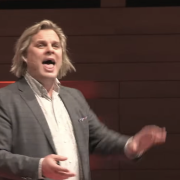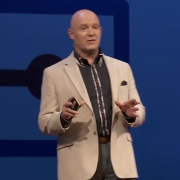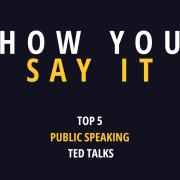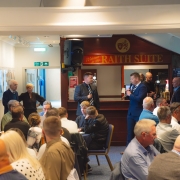Here’s my full guide and breakdown of what I believe are the key public speaking skills that can have a huge impact on how you communicate.
Public speaking can be defined in the Cambridge Dictionary as:
“The activity of speaking on a subject to a group of people.”
A lot of the time, we picture public speaking as standing on a stage or platform and speaking out into a vast audience. Or maybe we have an image of standing in a spotlight holding a microphone.
We all have our own perception of what public speaking looks like.
But when we break it down to its simplest form, the reality is that to speak publicly, it is merely speaking to a group of people about a particular subject.
There’s loads of questions that tend to follow that definition:
- How many people?
- What am I speaking about?
- Where am I speaking?
- How long am I speaking for?
- When am I speaking?
- How are the people I’m speaking to going to react?
All of these above questions can vary and for some people, the variables like; who, what, where, when and why can often change for every speaking occasion.
But when it comes to the skill and ability to speak publicly, it’s important to remember that regardless of if you’re speaking to 3 people or 3 million people, it’s often not about what you are saying, it’s about how you say it.
This public speaking guide is designed to provide insights and public speaking tips to help you navigate the complexities and nuances of how to get better at public speaking, ensuring your message is not only heard but also resonates with your audience.
Basics of Effective Communication
For me, when it comes to communicating effectively, the first aspect that is number one is awareness.
- Awareness of self
- Awareness of audience
- Awareness of environment
1. Awareness of Self
Who are you?
Are you the funny one, the serious one, the quiet one or the noisy one?
If you don’t fully know who you are, then how are you supposed to pass on a message and build trust with an audience?
Throughout all of the interviews that I have conducted on the How You Say It podcast, the one key fundamental that shines through is “always be yourself” and the importance of honesty.
And for a lot of people, being yourself can be difficult if you’re not aware of who you really are.
If you don’t normally use big and fancy words, then don’t try and use them.
Frances Frei and Anne Morriss believe that trust has three drivers: Authenticity, Logic and Empathy.
They use these three drivers as points in what they call “The Triangle of Trust”.
Authenticity is all about being the ‘real you’ and making an audience trust who you are.
If the audience trusts you, they’ll trust your message, and if they trust your message, they’ll likely do what you want them to do.
What Are You Doing?
We all have tendencies to do strange things with our bodies when we are speaking publicly.
- Hide our thumbs in our pockets
- Clasp our hands
- Stroke ourselves
- Hug ourselves
- Touch our faces
There are loads of signs that our bodies give away when we are nervous or under stress.
And we need to be aware of them.
If you’re aware that you fidget with the paper you’re holding, you need to know what to do to stop it.
You might pace too much, you might fidget with keys in your pocket, your hands might shake.
These are all perfectly common and very normal, the difference between the people who do these cues and the people who don’t is awareness.
Once you become aware that you are of these cues, you can work on strategies on how to catch yourself and stop doing them.
What Are You Saying?
Be aware of what you’re saying.
Sometimes we say things without meaning them.
Sometimes we say things and we didn’t even realise we’d said them.
A slip of the tongue or a lapse in concentration can be fatal when speaking.
Repeatedly using the same word, often unconsciously, can lead us to begin each sentence with fillers such as ‘so’ or ‘obviously’.
“So this is my blog article on public speaking. So the reason behind it is to help people get better at speaking. So when I first started writing this I didn’t realise how silly this looks when it’s written down. So that’s my example.”
Awareness is key to identifying this habit. Once you’re conscious of it, you can take steps to address it.
2. Awareness of Audience
Who are your audience?
Audiences vary with each presentation, making it crucial to understand who you’re speaking to. Recognising this can mean the difference between a resounding success and a complete failure.
Being knowledgeable about your audience’s demographics, such as age, gender, and cultural backgrounds, informs the language, tone, and even the duration of your speech.
Would a room full of hungry kids want to listen to someone speak for more than 2 mins?
Understanding your audience is crucial to customise both your message and delivery style for maximum effect.
If people are at a stand-up comedy gig, they want to laugh, they’re expecting to laugh. So using humour is a fundamental requirement.
However, when people are at a funeral, humour has to be used only if necessary and completely appropriate.
Being aware of your audience helps you prepare and craft a speech that lands.
A lack of awareness can feel like a lack of respect for your audience.
3. Awareness of Environment
William Henry Harrison was the 9th President of the United States.
He holds two presidential records; the longest inaugural address which took nearly 2 hours and, the shortest running presidency in U.S. history.
Harrison died just 31 days after his epic inaugural address, which he did outside on the 4th of March on a cold and wet day without an overcoat or hat.
It is largely believed that his death was related to the cold and ‘flu-like symptoms that he suffered from in the days and weeks after his cold and wet speech.
Pay attention to your surroundings.
Stuart Mitchell, a comedian, emphasised how crucial the setting is for comedy’s success.
He pointed out that factors like inadequate lighting, the vast distance between the audience and the stage, or the absence of a stage altogether can significantly impact the outcome of a performance.
Is the venue overly spacious or uncomfortably cramped? What about the temperature conditions?
Often, these details become apparent only upon arrival at the venue.
Stuart went on to say that on some occasions, he’ll address the environment in his act to try and engage with the audience.
But if it’s a cold and wet day and you’re outdoors, learn from poor old William Henry Harrison and have the awareness to cut your speech short, or make sure you’re wrapped up warm.
Preparation and Delivery
Practice and Preparation
“You can’t practice public speaking, you can only prepare for how you’ll feel when you’re speaking” – DK, The Public Speaking Lesson you Never Had
A lot of people mistaken practice for preparation.
Practice involves repeatedly performing an action, with the aim of enhancing and refining your skills over time
A common error many make is assuming that being able to speak means they don’t need further practice or improvement in their speaking skills.
We can always get better and learn new ways to enhance how we speak.
By practicing, you get yourself used to going through a process.
You can hone your message, you can enhance the language you want to use and you can practice building suspense.
Comedians practice ‘new material’ on audiences to test and refine all the time.
But what’s the difference between practicing and preparing?
If you practice a speech, you’ll begin to learn it word for word.
However, simply memorising your speech word for word doesn’t necessarily prepare you for the emotions you’ll experience during delivery.
Are you ready for the audience’s response to your words?
Have you considered how to handle potential disruptions, such as a lapse in memory or a momentary loss of focus?
We might avoid contemplating such situations, viewing them as the worst-case outcomes, yet being prepared for these eventualities can instil confidence and readiness to tackle them effectively.
For me, it’s about doing the preparation first.
Thorough preparation demonstrates to your audience that you have considered their perspective, adding depth and significance to your message.
Incorporating references to particular individuals or events familiar to the audience can help establish a connection between you and them.
Prepare for how people might react to what you are saying.
Before you begin writing or practicing, you need to think about how you want people to feel during your speech.
That begins the process of how to craft the message and the objective of the speech.
When it comes to preparing a speech, I focus on the process of Facts – Feeling – Actions.
- Facts – What do I know and what do I want my audience to know by the end of my speech?
- Feelings – How do I want to make my audience feel? What emotions do I want to trigger?
- Action – What action do I want the audience to take after my speech?
For me, visualisation is key, I begin to picture how my speech will flow.
I contemplate the delivery of specific segments, identifying which parts should carry the greatest impact and strategising on how to achieve that effect.
I prepare for people’s responses.
What if someone disagrees or challenges me?
What If people don’t find the punchline funny enough?
And this is when I begin to move into the practice part of my preparation.
I practice how I want to say the speech. I practice telling the story I want to use to deliver the key message.
I say it out loud, I think about it, I think about how it could sound with a different tone or different language and I say it again.
And I repeat the process over and over and over again.
I’m always nervous before I begin any speaking engagement, but those nerves are more excitement than anxiety.
Anxiety and stress come down to a lack of control.
However, with adequate preparation, consistent practice, and adherence to your methodology, you’ll maintain control, effectively reducing stress and anxiety.
Choosing Your Topic
The easiest thing in the world to talk about is yourself.
We all have a story to tell, the only thing that makes it interesting or not is how we tell it to people.
The first speech I ever did was an ‘About Yourself’ speech.
It wasn’t a life story from birth to the current moment I was in, but it was a speech explaining to the audience who I was and why I was speaking to them.
Know Your Topic
The point of that speech was that nobody knows you as well as you know yourself.
And when it comes to speaking publicly about a particular topic, you need to know what you’re talking about.
If the audience gets the smallest of hints that you don’t know what you are talking about, they’ll lose trust and begin to feel uneasy.
That uneasiness will begin to spread and if you become aware of it, you’ll become uneasy.
There’s a huge difference between being vulnerable (which is often a good thing) and being out of your depth.
Vulnerability can build trust, but faking it in front of people who know the topic better than you do, can kill trust completely.
Know what you’re talking about.
Knowledge is powerful, but be careful not to be too knowledgeable.
Stay away from using jargon and complex language which can highlight how knowledgeable you are on the topic, but isolate people in the audience who don’t know what you mean.
It becomes a fine balance in knowing how to tread this line, but that’s why preparation and awareness become so important.
It’s not what you say, it’s How You Say It
The execution of each speech holds significant weight.
If the delivery isn’t right, the focus, message, and entire purpose of the speech risk being overlooked by the audience.
Once you know who the audience is, the intention of the speech, and the message you want to hit home, you need to know how you’re going to deliver it.
The two main parts of the brain that we use during communication are the prefrontal cortex and the limbic system.
The prefrontal cortex functions largely on logic and rational thought, while the limbic system is mainly governed by emotions.
These two parts of the brain can operate as opposites which is often why we find ourselves feeling conflicted between logic and emotion, often referred to as ‘head vs heart’.
The limbic system is the part of the brain that processes what we see, hear and feel instantly, it i is linked to our instinctual ‘fight, flight, or freeze’ reactions.
This is the part of our brain that picks up on body language, facial expression and tone of voice.
If someone is speaking in an aggressive tone, raising their voice, has an angry look on their face and are clenching their fists, our brain will recognise this as a threat and respond with a ‘fight, flight or freeze’ reaction.
Whereas, if someone has a smile on their face, raised eyebrows, uses softer tones and has their arms open towards us, we will process this as open and welcoming and not threatening.
In these scenarios, the focus isn’t on the spoken words themselves but rather on the speaker’s actions and the manner in which they communicate.
Non-verbal communication conveys messages without the need for spoken words.
Body language plays a crucial role in communication, revealing a great deal through our physical actions, whether we’re speaking or silent.
And this is a hugely powerful tool that can be used to emphasise the intention and message we want to deliver when we speak.
Speaking quickly can emphasise urgency, speaking quietly can build suspense, using a strict and direct tone can ensure people understand that you are serious.
Raising your eyebrows, opening your body with your palms up and smiling is a welcoming gesture and will make your audience feel comfortable and not threatened.
By learning about body language, you can use them as tools to manipulate how we want our audience to feel before we’ve even said a word.
However, if what your body language contradicts what you are saying, then this will cause confusion with the audience.
Confusion can foster doubt, potentially undermining the audience’s trust in you and your message.
Even with an exceptionally inspiring and motivational speech prepared, its impact and intention will be diminished if presented with uncertain body language and a monotone delivery.
It’s important to know about non-verbal communication and how much impact we can create through how we use our voice and body language.
“Communication is the transfer of emotions” – Seth Godin
Overloading speeches and presentations with information, stats and facts won’t generate emotional responses and we don’t know how much of that information will be remembered.
They’ll remember how they felt.
Stats, facts and information are processed by the prefrontal cortex which has rational and logic but no emotion.
If we want to create an emotional response, we need to communicate to the limbic system.
I’m not saying that you shouldn’t use stats, facts and figures in your speeches. Often these are important elements and it might even be the reason for speaking publicly in the first place, e.g. presenting sales figures to investors.
However, listing them and presenting them in a PowerPoint might look good and will get the necessary information in front of everyone who needs to see it.
But will it have the desired impact and generate an emotional response?
Tell the Story
It is thought that the ancient hieroglyphics were religious stories being passed through generation to generation.
We learn important messages throughout our childhood from stories being told or read to us.
We can use stories to emphasise the intention and message we want to deliver when we speak.
Why dull the audience with an overload of numbers, data, and pie charts in a sales presentation when you can captivate them with a story woven through the figures?
- Set the scene by providing context.
- Introduce characters.
- Identify the conflict or challenge to overcome.
- Describe the journey – what did you do to overcome the challenges?
- Highlight key moments – talk about the ups and the downs.
- Finish with the lesson/message/call to action.
Plot development is the way in which a story unfolds. The most simple form of telling a story is having a beginning, middle and ending.
But within all good stories, there is character development, twists and turns and an ending with meaning or purpose or a call to a action.
The teller knows where the story is going, the audience is on a journey with the speaker, but they don’t know where they will be taken.
Telling a good story involves knowing how to create intrigue through pace, tone, language and following a plot that develops right up to the end.
If you master how to tell a story, you’ll be able to get your point across, share knowledge and create influence with your audience.
Stories are the best way to communicate with emotion and meaning. People remember them, they remember how they felt when hearing the story and they’ll learn from the moral and the message of the story.
If you master how to tell a story, you’ll be able to get your point across, share knowledge and create influence with your audience.
Stories are the best way to communicate with emotion and meaning. People remember them, they remember how they felt when hearing the story and they’ll learn from the moral and the message of the story.






